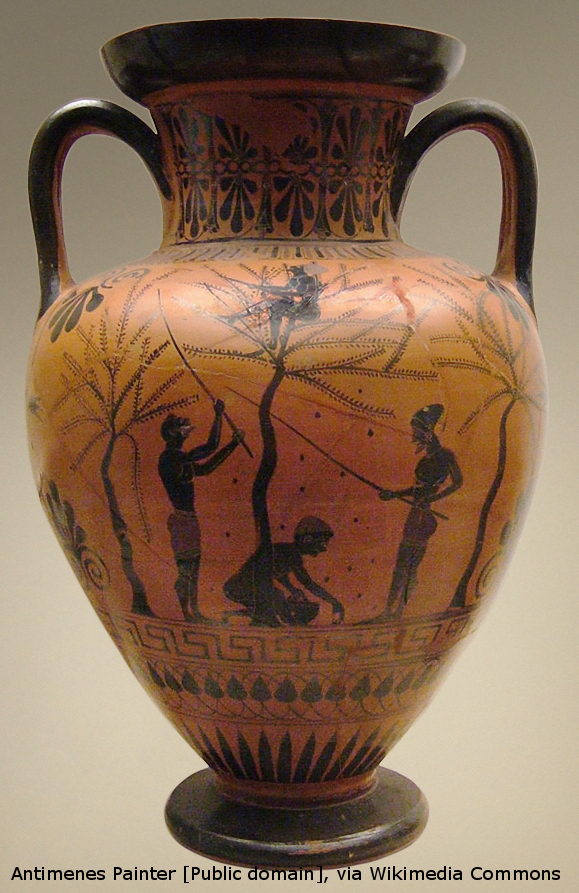By Louise Denning
An olive branch shown with a dove is often depicted on Christmas cards to symbolise peace and goodwill amongst men.
Where this concept of the olive branch representing peace originated from is unknown but it is likely to go back to the ancient Greeks. Legend states that during the founding of a city-nation in Ancient Greece, Athena and Poseidon went against each other for its patronage. To bribe the new citizens, Poseidon presented them with a new spring. Even though this impressed the citizens, when some of them decided to taste the water they found it to be pure sea water. With half her battle already won by her competitor’s faux pas, Athena presented the citizens with the first domesticated olive tree. In her honour, the grateful inhabitants named their new city after her. Even today, modern Athenians during the summer droughts wonder whether they should have asked Poseidon to rethink his gift instead of rejecting him straight away…
In addition, the olive branch is connected with the ancient Olympic Games where the victors of competitions were awarded with a wreath of olive branches, made from a wild olive tree found inside Hera’s Temple in Olympia. Wars between Greek-states were suspended during the games which is perhaps where the symbol of peace originates. Alternatively as the Olive tree takes between 5 to 7 years to produce fruit, it could only be successfully cultivated and harvested during periods of peace.
The dove and olive branch symbolism is also linked to early Christianity, especially the Old Testament. In the story of Noah, a white dove returns to the Ark with a single olive branch, symbolising the end of The Flood. The olive branch is still considered to represent peace for example it is depicted on United Nations flag and logo.
The olive tree is a native of The Mediterranean region – in the plant family Oleaceae, which includes Fraxinus excelsior (Ash) and Ligustrum vulgare (Wild Privet) in the UK. The fruit (a drupe) is an important source of food and oil. Olive production in parts of the Mediterranean is vital to the economy, and plays an important heritage/ socio-cultural role. It is especially important in marginal regions with poor productivity (mountainous or hilly areas); Olive trees can grow in poor, stony soil which it would be difficult to put to other crop uses (European Commission 2012). Olive production using traditional methods requires significant labour, and provides agricultural work during the autumn and winter (the peak harvest period).
The Olive is a long-lived evergreen tree between 8 – 15m tall; the oldest specimens are between 2000-3000 years old for example the Olive Tree of Vouves on the island of Crete. Olive trees are hardy and drought-, disease- and fire-resistant — part of the reason for their longevity and their widespread use in the Mediterranean region.
Interesting facts about the Olives
- The world consumes about 2.25 million tonnes of olive oil a year.
- It takes seven litres of olives to make one litre of olive oil.
- Olives are rich in Vitamin E and ‘good fat’.
- Your five daily portions of fruit can include 16 olives, which make one portion.
- Green olives are harvested first while the black ones are allowed to ripen naturally on the tree.
- Today there are over 800 million olive trees planted worldwide.
- The first eye shadow was created in Ancient Greece by mixing ground charcoal with olive oil.
- It was used by Roman women as protection from the sun
References
https://en.wikipedia.org/wiki/Olive_branch
European Commission (2012). Economic analysis of the olive sector http://ec.europa.eu/agriculture/olive-oil/economic-analysis_en.pdf
Olive of Vouves – http://www.olivemuseumvouves.com/pages.aspx?id=2&lang=en
United Nations – http://www.un.org/Depts/dhl/maplib/flag.htm
Interesting Facts – http://www.loveolive.co.uk/olivefacts.html
Laws, B. (2010) Fifty Plants that changed the course of history.






Pingback: Advent Botany 2015 – Day 14: the Olive « Herbology Manchester
Pingback: Whewell’s Gazette: year 2, Vol. #23 | Whewell's Ghost